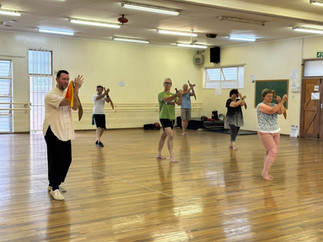Find Your Flow: Discover Inner Peace and Grace with Tai Chi & Qi Gong
- Juan Farah
- Apr 18
- 4 min read
In a world that constantly rushes, where do you find your anchor? How do you cultivate calm amidst the chaos? For centuries, the ancient arts of Tai Chi and Qi Gong have offered a pathway – a gentle, flowing journey back to ourselves, nurturing balance, strength, and profound inner peace. If you're seeking harmony for your body, heart, and spirit, perhaps it's time to explore these transformative practices.
What are Tai Chi and Qi Gong?
Often described as "meditation in motion," Tai Chi – more formally Taijiquan or T'ai Chi Ch'üan (太極拳) – and Qi Gong (氣功) are sister practices originating in China. They involve slow, deliberate movements, coordinated with deep breathing and mindful awareness.
Qi Gong (Qìgōng, meaning "energy work") focuses on cultivating and balancing the body's vital energy (Qi) through specific postures, movements, and breathing techniques.
Tai Chi (Tàijíquán, meaning "Supreme Ultimate Fist") is a form of Qi Gong, often appearing more complex with its flowing sequences (forms). It integrates mindful movement, philosophical principles, and energy cultivation, rooted in martial applications but primarily practised today for health and well-being.
Together, they offer a holistic approach, connecting mind, body, and breath in a graceful dance.
Roots in Ancient Wisdom
While shrouded in legend, the creation of Tai Chi as we know it today is often traced back to the Chen village (Chenjiagou) in 17th century China. It's believed that Chen Wangting, a retired army general, synthesized existing martial arts forms with principles of traditional Chinese medicine (like Qi flow and meridians), breathing techniques from Qi Gong, and the profound philosophical concepts of Taoism – particularly the interplay of Yin and Yang (complementary opposites).
Though not directly founded by Lao Tzu (老子, Lǎozǐ), the sage credited with the Tao Te Ching (道德經, Dào Dé Jīng), Tai Chi is deeply infused with Taoist ideals of harmony, effortless action (Wu Wei), yielding, and flowing with the natural cycles of life. From the original Chen style, other major family styles like Yang, Wu, Hao, and Sun evolved, each preserving the core principles.
A Journey, Not a Destination
As local Tai Chi and Qi Gong Master, Richard Boyder, beautifully describes it, "Tai Chi is a journey of art that never ends like a paint brush on a never ending canvas." With 20 years dedicated to Yang Style Tai Chi, and later expanding his expertise to include the Competition 42-posture form and Chen family Style Old forms, Richard Boyder embodies this continuous journey of learning and refinement.
For him, the practice has yielded immense personal gifts: "a deeper sense of balance, gracefulness in movement, peace, strength of the joints and deeper aspects of combining movement with breathing while keeping the mind calm." It's this profound personal experience that fuels his passion for teaching.
Guidance from a Master's Heart
Stepping into the teaching role after his teacher, Andre Dupree, passed away post-Covid, Richard Boyder doesn't just instruct; he guides. He shared, "I really enjoy helping people learn the postures… go deeper into their own bodies with understanding the concepts of yin and yang as they relate to Tai Chi and the body..." His approach is rooted in the belief that everyone has untapped inner depths, and these practices are powerful tools to access them.
He speaks of helping students find "that each person has a deep level within themselves and Tai Chi can help them find it." This isn't just about physical exercise; it's about inner discovery and healing. "No matter what one has been through in life," he affirms, "Tai Chi helps on many levels."
Cultivating Your Inner Sanctuary
Imagine creating "a peaceful lake inside your heart, or perhaps a quiet forest inside where Tai Chi moves into and you never lose" that feeling. This evocative image captures the essence of what dedicated practice, under compassionate guidance, can foster. It's about building resilience, finding a calm centre that remains steady regardless of external storms, and nurturing your body, heart, and spirit simultaneously.
The ancient wisdom underpinning Tai Chi often speaks to this resilience through metaphors of nature, particularly water. Lao Tzu, in the Tao Te Ching, observed:
"Under heaven nothing is more soft and yielding than water.
Yet for attacking the solid and strong, nothing is better;
It has no equal.
The weak can overcome the strong;
The supple can overcome the stiff.
Under heaven everyone knows this,
Yet no one puts it into practice."1
(Tao Te Ching, Chapter2 78)
This principle of yielding, flowing, and allowing softness to overcome rigidity is central to the practice and the inner balance it cultivates.
Is This Journey for You?
If you seek:
Reduced stress and increased calm
Improved balance and coordination
Gentle strengthening, particularly for joints
Better mind-body connection
A practice that feels like moving meditation
A supportive community and experienced guidance
...then the answer is likely yes! Tai Chi and Qi Gong are accessible to people of various ages and fitness levels.
Begin Your Journey Today
Ready to step onto that never-ending canvas and discover the peaceful lake within? Join Richard Boyder and experience the profound benefits of Tai Chi and Qi Gong for yourself.
You can find more information, class details, and connect with Richard here:
Begin your journey today!









Comments